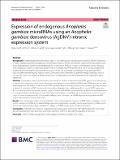| dc.contributor.author | Johnson, Rebecca M. | |
| dc.contributor.author | Metz, Hillery C. | |
| dc.contributor.author | Suzuki, Yasutsugu | |
| dc.contributor.author | McLean, Kyle J. | |
| dc.contributor.author | Rasgon, Jason L. | |
| dc.date.accessioned | 2025-10-23T22:00:11Z | |
| dc.date.available | 2025-10-23T22:00:11Z | |
| dc.date.issued | 2025-08-19 | |
| dc.identifier.uri | https://hdl.handle.net/1721.1/163380 | |
| dc.description.abstract | Background Anopheles gambiae densovirus (AgDNV) is a highly species-specific parvovirus that reaches high titers in adult Anopheles gambiae mosquitoes with few transcriptomic effects and minimal significant fitness effects. Given these characteristics, AgDNV has been proposed as a viral vector for basic research and mosquito control. Previous work created an AgDNV co-expression system with a wild-type AgDNV helper plasmid and a transducing plasmid expressing enhanced green fluorescent protein (EGFP) that can be used to co-transfect cells to generate infectious recombinant transducing AgDNV virions. Generated virions infect the An. gambiae midgut, fat body, and ovaries, yet this viral vector system is limited in the size of transgenes that can be expressed due to capsid packaging limitations. Methods Considering these size constraints, we created an artificial intron within the EGFP gene of the transducing construct that can express small pieces of genetic material such as microRNAs (miRNAs), microRNA sponges, or other small sequences. Placement of this intron in EGFP created a fluorescent reporter such that incorrect splicing produces a frameshift mutation in EGFP and an early stop codon, whereas correct splicing results in normal EGFP expression and co-transcription of the intronic genetic cargo. A selection of miRNAs with predicted or demonstrated importance in mosquito immunity and reproduction with expression localized to the fat body or ovaries were chosen as intronic cargo. Construct expression and splicing was evaluated, and the impact of miRNA expression on putative miRNA targets was measured in vitro and in vivo. Results The created intron was correctly spliced in cells and mosquitoes; however, miRNA delivery resulted in inconsistent changes to miRNA and predicted target gene transcript levels—possibly due to organ-specific miRNA expression or inaccurate putative target predictions leading to miRNA–target gene sequence mismatch. Conclusions Although our results on target gene expression were inconsistent, with optimization this viral vector and developed intron have potential as an expression tool within An. gambiae mosquitoes or cell lines. | en_US |
| dc.publisher | BioMed Central | en_US |
| dc.relation.isversionof | https://doi.org/10.1186/s13071-025-06994-7 | en_US |
| dc.rights | Creative Commons Attribution | en_US |
| dc.rights.uri | https://creativecommons.org/licenses/by/4.0/ | en_US |
| dc.source | BioMed Central | en_US |
| dc.title | Expression of endogenous Anopheles gambiae microRNAs using an Anopheles gambiae densovirus (AgDNV) intronic expression system | en_US |
| dc.type | Article | en_US |
| dc.identifier.citation | Johnson, R.M., Metz, H.C., Suzuki, Y. et al. Expression of endogenous Anopheles gambiae microRNAs using an Anopheles gambiae densovirus (AgDNV) intronic expression system. Parasites Vectors 18, 355 (2025). | en_US |
| dc.contributor.department | Massachusetts Institute of Technology. Department of Biological Engineering | en_US |
| dc.relation.journal | Parasites & Vectors | en_US |
| dc.identifier.mitlicense | PUBLISHER_CC | |
| dc.eprint.version | Final published version | en_US |
| dc.type.uri | http://purl.org/eprint/type/JournalArticle | en_US |
| eprint.status | http://purl.org/eprint/status/PeerReviewed | en_US |
| dc.date.updated | 2025-10-08T14:38:23Z | |
| dc.language.rfc3066 | en | |
| dc.rights.holder | The Author(s) | |
| dspace.date.submission | 2025-10-08T14:38:23Z | |
| mit.journal.volume | 18 | en_US |
| mit.license | PUBLISHER_CC | |
| mit.metadata.status | Authority Work and Publication Information Needed | en_US |
